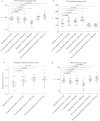Effects of hydrocortisone on acute β-adrenoceptor blocker and histamine induced bronchoconstriction - PubMed (original) (raw)
Randomized Controlled Trial
Effects of hydrocortisone on acute β-adrenoceptor blocker and histamine induced bronchoconstriction
Philip M Short et al. Br J Clin Pharmacol. 2012 May.
Abstract
Aims: β-adrenoceptor blockers are avoided in asthma due to concerns of bronchoconstriction. We investigated the safety of acute exposure to propranolol in asthmatics, sequentially challenged with histamine to mimic an asthma exacerbation and evaluated the role of intravenous hydrocortisone in potentiating salbutamol reversibility.
Methods: Persistent atopic asthmatics, requiring ≤ 1000 µg day(-1) budesonide, performed a randomized double-blind placebo-controlled crossover study. Following 10 mg or 20 mg of oral propranolol, patients received 400 mg intravenous hydrocortisone or placebo, followed by histamine challenge with nebulized salbutamol 5 mg and ipratropium 500 µg recovery.
Results: Thirteen patients completed per protocol. Hydrocortisone did not potentiate salbutamol recovery post propranolol and histamine challenge vs. placebo (mean difference in FEV(1) 0.04 ml, 95% CI -0.07, 0.15, P= 0.417). β-adrenoceptor blocker induced bronchoconstriction was demonstrated by spirometry and impulse oscillometry. For the placebo visit, FEV(1) fell 4.7% 2 hours post propranolol (95% CI 1.8, 7.5, P= 0.008) whilst total airway resistance (R5%) increased 31.3% (95% CI 15.6, 47.0, P= 0.04). On both visits FEV(1) % and R5% returned to baseline after salbutamol post histamine.
Conclusion: Nebulized salbutamol and ipratropium produced a full recovery after propranolol and histamine induced bronchoconstriction, independent of hydrocortisone use. Since the greatest risk of β-adrenoceptor blockade is after first dose, our findings offer reassurance to those undertaking further evaluation of chronic β-adrenoceptor blockade as a potential treatment for mild-to-moderate asthma.
Trial registration: ClinicalTrials.gov NCT01070225.
© 2011 The Authors. British Journal of Clinical Pharmacology © 2011 The British Pharmacological Society.
Figures
Figure 1
Study visit diagram. Hist histamine, salb salbutamol, IP ipratropium
Figure 2
Consort diagram
Figure 3
Effect of β-adenoceptor blockade, bronchial challenge and sequential reversibility with salbutamol and ipratropium on separate study visits (hydrocortisone and placebo). FEV1% (A and D), R5% (B and E) and serum potassium (D and F)
Figure 3
Effect of β-adenoceptor blockade, bronchial challenge and sequential reversibility with salbutamol and ipratropium on separate study visits (hydrocortisone and placebo). FEV1% (A and D), R5% (B and E) and serum potassium (D and F)
Similar articles
- Sensitivity of impulse oscillometry and spirometry in beta-blocker induced bronchoconstriction and beta-agonist bronchodilatation in asthma.
Short PM, Williamson PA, Lipworth BJ. Short PM, et al. Ann Allergy Asthma Immunol. 2012 Dec;109(6):412-5. doi: 10.1016/j.anai.2012.09.010. Epub 2012 Oct 18. Ann Allergy Asthma Immunol. 2012. PMID: 23176879 Clinical Trial. - Salbutamol but not ipratropium abolishes leukotriene D4-induced gas exchange abnormalities in asthma.
Dahlén B, Gómez FP, Casas A, Howarth PH, Dahlén SE, Rodriguez-Roisin R. Dahlén B, et al. Eur J Clin Pharmacol. 2012 Oct;68(10):1375-83. doi: 10.1007/s00228-012-1256-z. Epub 2012 Mar 29. Eur J Clin Pharmacol. 2012. PMID: 22457014 Clinical Trial. - TPI 1020, a novel anti-inflammatory, nitric oxide donating compound, potentiates the bronchodilator effects of salbutamol in conscious guinea-pigs.
Turner DL, Ferrari N, Ford WR, Kidd EJ, Paquet L, Renzi P, Broadley KJ. Turner DL, et al. Eur J Pharmacol. 2010 Sep 1;641(2-3):213-9. doi: 10.1016/j.ejphar.2010.05.025. Epub 2010 Jun 8. Eur J Pharmacol. 2010. PMID: 20639142 - Comparison of salmeterol and albuterol-induced bronchoprotection against adenosine monophosphate and histamine in mild asthma.
Taylor DA, Jensen MW, Aikman SL, Harris JG, Barnes PJ, O'Connor BJ. Taylor DA, et al. Am J Respir Crit Care Med. 1997 Dec;156(6):1731-7. doi: 10.1164/ajrccm.156.6.9703047. Am J Respir Crit Care Med. 1997. PMID: 9412548 Clinical Trial.
Cited by
- Effects of respiratory motion on coronary wall MR imaging: a quantitative study of older adults.
Lin K, Lloyd-Jones DM, Bi X, Liu Y, Li D, Carr JC. Lin K, et al. Int J Cardiovasc Imaging. 2013 Jun;29(5):1069-76. doi: 10.1007/s10554-013-0187-9. Epub 2013 Feb 3. Int J Cardiovasc Imaging. 2013. PMID: 23378158 Free PMC article. - Respiratory effect of beta-blockers in people with asthma and cardiovascular disease: population-based nested case control study.
Morales DR, Lipworth BJ, Donnan PT, Jackson C, Guthrie B. Morales DR, et al. BMC Med. 2017 Jan 27;15(1):18. doi: 10.1186/s12916-017-0781-0. BMC Med. 2017. PMID: 28126029 Free PMC article. - Beta-blockers: friend or foe in asthma?
Arboe B, Ulrik CS. Arboe B, et al. Int J Gen Med. 2013 Jul 8;6:549-55. doi: 10.2147/IJGM.S46592. Print 2013. Int J Gen Med. 2013. PMID: 23882156 Free PMC article.
References
- Black JW, Crowther AF, Shanks RG, Smith LH, Dornhorst AC. A New adrenergic betareceptor antagonist. Lancet. 1964;1:1080–1. - PubMed
- McNeill RS. Effect of a beta-adrenergic-blocking agent, propranolol, on asthmatics. Lancet. 1964;2:1101–2. - PubMed
- Committee on Safety of Medicines. Current problems. 1987. No. 20.


